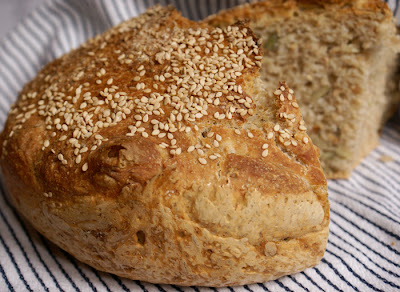Toen ik in Nederland kwam wonen, vond ik het Nederlands brood heerlijk. Vooral Waldkorn was mijn lievelings brood. Zo zacht, zo vierkant, zo donker, zo handig - al gesneden. Met al dat verschillende beleg was voor mij elk ontbijt en/of lunch een echte gebeurtenis. Ik vond het spannend dat ik zo veel verschillende combinaties kon samenstellen.
Dat ging zo ongeveer een jaar. Toen had ik genoeg. Ik had geen zin in al dat verschillende broodbeleg meer. Ik was op zoek naar iets anders en ik kocht elke keer een ander brood. Het hielp niet, want ik wist niet wat ik echt miste.
Daarna gingen wij naar Slovenië op bezoek bij mijn ouders. Bij het ontbijt ontdekte ik wat ik miste in Nederland. Gewoon brood! Dat is geen vierkant brood, maar het heeft een heerlijk korst en grote gaten. De textuur van dat brood is heel anders dan van een Nederlands brood. Het is meer kauwbaar en bevat meer water (denk ik), daarom blijft het ook langer vers.
Terug in Nederland was ik terug bij het eten van Nederlands brood. Maar ik was op zoek naar een oplossing. Brood bakken leek mij altijd heel ingewikkeld. Mijn moeder deed dat nooit en als gevolg daarvan heb ik daar ook helemaal geen kennis over. Ik heb een keer geprobeerd een broodje te bakken meet een broodmix, maar dat mislukte echt.
En toen kwam ik terecht dit recept op het internet. Ik noem dit brood luilakken brood want je hoeft helemaal niets te doen, de tijd doet alles voor je. En bovendien is het zo eenvoudig, dat een kind het zou kunnen doen.
LUILAKKEN BROOD A.K.A NO-KNEAD-BREAD
Ingrediënten:
- 430g tarwebloem (of een deel tarwebloem en een deel volkorenbloem)
- ¼ theelepel droge gist
- 1 ½ theelepel zout
- 345ml water
- sesam zaad of pompoenpitten (optioneel)
Meng eerst tarwebloem, droge gist en zout samen. Voeg water toe en roer met een lepel snel totdat alles gemengd is – niet te lang. Doe de folie op de kom of doe de kom in een plastic zak, zodat het deeg niet uitgedroogd wordt. Laat alles staan op de kamertemperatuur voor 12 (tot 18) uur.
Na 12 (of 18) uur, maak wat ruimte op het aanrecht schoon een bestrooi het goed met tarwe. Het deeg is een beetje zacht geworden en zal een beetje plakken aan de bodem van de kom. Neem het deeg uit de kom en leeg het op de tarwe op het aanrecht. Gebruik een lepel om alles uit te krabbelen. Maak de kom schoon met wat warm water en doe er een dun laagje olie binnen (gewoon met wat keukenpapier). Bestrooi het deeg met bloem, trek het rustig een klein beetje uit elkaar en vouw twee uiteinden over elkaar. Draai het deeg een kwartslag en herhaal de handeling.
Bestrooi de bodem van de kom met wat zaadjes en doe het deeg erop. Doe weer de folie erover en laat staan voor 1 tot 3 uur.
Zet een lege bakvorm (ik gebruik een pyrex schaal) met een ovenbestendig deksel in de oven en verwarm alles op de hoogste temperatuur. Het is belangrijk dat het echt goed voorverwarmd is, anders plakt het brood op de bodem van de schaal.
Hier komt het moeilijkste deel van dit recept. Neem het plakkerige deeg uit de kom en gooi het in de hete schaal. Bestrooi met wat sesam zaadjes. Doe de deksel erop en zet alles in de oven. Verwijder de deksel na 30 minuten en bak nog 15 minuten. Neem het brood uit de pan en laat het op een rooster volledig afkoelen voordat je het aansnijdt.
Ik vind dit brood echt heerlijk. Het lijkt op brood dat ik in Slovenië eet. En het is echt makkelijk om te maken. 's Ochtends meng ik alles en 's avonds bak ik. En volgende ochtend eten we lekker zelfgemaakt brood voor ontbijt.
 |
| From Food |
Op deze afbeelding is brood gemaakt met 2/3 witte tarwebloem en 1/3 volkorenbloem. Er is ook wat pompoenpitten toegevoegd - gewoon samen met de bloem in het begin.